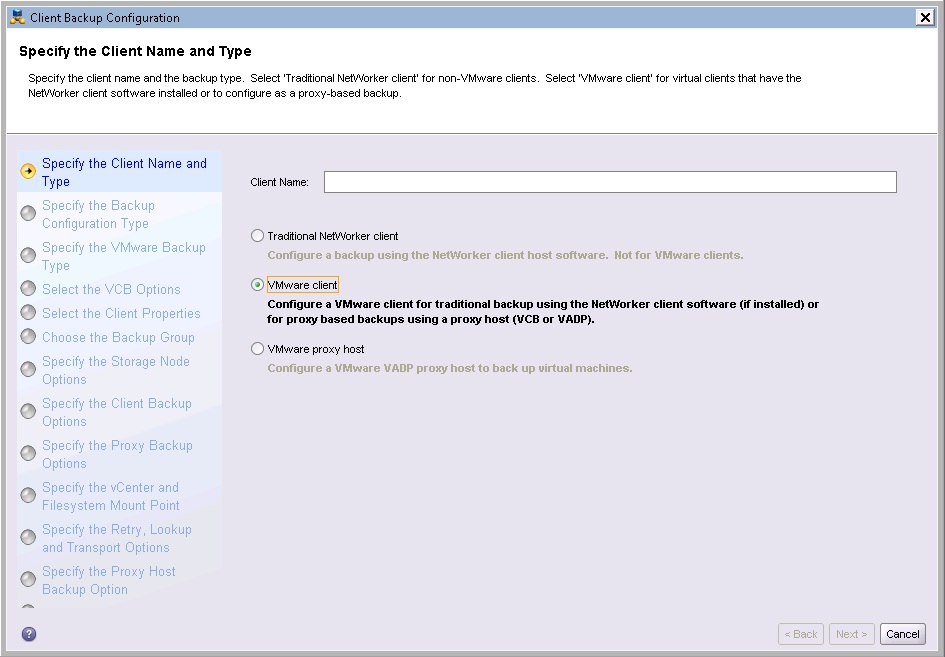Since VMware entered the server space, a simple problem has plagued backup administrators:
- Backup via a client installed in the VM? or
- Backup the virtual machine files.
I like to all this agent vs spy. The agent is the conventional client software, and the spy is the mechanism that allows a backup of the virtual machine files. It’s a “spy” of course because it’s ‘serverless’ as far as the virtual machine is concerned.
NetWorker has supported three distinct backup mechanisms – VCB, VADP and now VBA. Each have had their own unique qualities, but the mechanism has been becoming progressively more sophisticated over time.
The question often remains … when should you backup via agent, and when should you backup via a spy?
For the most part, if you’re running database style applications within virtual machines, the answer is still a simple one – the closer the backup software is to your data, the more guarantee you have of getting a fully application-consistent backup. So if you’re running Oracle or Exchange in a virtual machine, you’ll still want to do an agent-based backup with the appropriate module software also installed. Additionally, when you want cross-system consistency (e.g., for Sharepoint, Blackboard, Documentum systems, etc.), you’ll likely want to resort to in-VM agents to keep a highly granular control.
There’s no doubt that’s going to change over the coming years. I don’t see a point where in-guest agents will completely disappear, but there will very likely be a time where they’re no longer the majority method for backup.
So what are some good use-case scenarios for out-of-guest backup scenarios in NetWorker for virtual machines?
Here’s a quick list:
- LAN minimisation: I wouldn’t call it LAN-free, but if you can use fibre-channel connectivity between VMware LUNs and proxies in NetWorker, you may have the potential to drastically reduce the amount of LAN traffic involved in a backup. This could come in one of two ways:
- Fibre-channel accessible media (e.g., tape or virtual tape) directly connected to a proxy – this results in only backup metadata traversing the IP network;
- Dedicated backup IP network – OK, this could be done regardless of whether you’re using guest or host based backup software, but if the data is coming off fibre from the disks and going over a private backup network divorced from the network of the virtual machine, you’ve effectively gone LAN-free as far as the virtual machine is concerned;
- License minimisation: If you’re using conventional NetWorker licensing, and you have a reasonably dense allocation of virtual machines per ESX server, then you could get considerably more bang for buck out of your backup environment using virtual client licensing rather than per-VM client licensing;
- Disaster recovery: If you don’t have SRM or other replication technology in your environment, then NetWorker’s ability to do image level recovery from Virtual Machine backups is the next closest thing you’ll get;
- Side-stepping firewalls: Even permissive firewalls can be a pain when it comes to backup – it’s easier to swamp the link if there’s a limited number of ports open; if your firewalled machines are accessible from a vCenter server sans-firewall, you’ll likely get better backup throughput targeting the virtual machine files than the guest files. Also, the backup process is going to be completely hidden from the guest, improving security. You might be able to completely sidestep the firewall via fibre-channel connection to LUNs, or you might be able to at least minimise it by keeping communication between proxies and vCenter/ESX servers;
- Easier enabling of backups: OK, by rights you should have decent change control within your organisation, and no new host should be able to commissioned without a checkbox being ticked or crossed on “[] Backups required”, but that’s not always guaranteed. Close integration between NetWorker and vCenter can allow easier identification of what is and isn’t being backed up … and that’s just getting better as time goes by;
- Instant-on recovery: Introduced in Avamar 7, and sure to eventually make an appearance in NetWorker 8.x is instant-on recovery. That’s where Avamar, when writing to Data Domain, can generate virtual machine backups that can be powered on from the Data Domain and VMotion’d back into production storage while they’re being used.
They’re not the only reasons of course – I wasn’t trying to create a definitive list. As always, each site is different. But if you’ve got NetWorker and VMware, you really owe it to yourself to check out the features and see if they can work together to make your life as a backup administrator easier.
